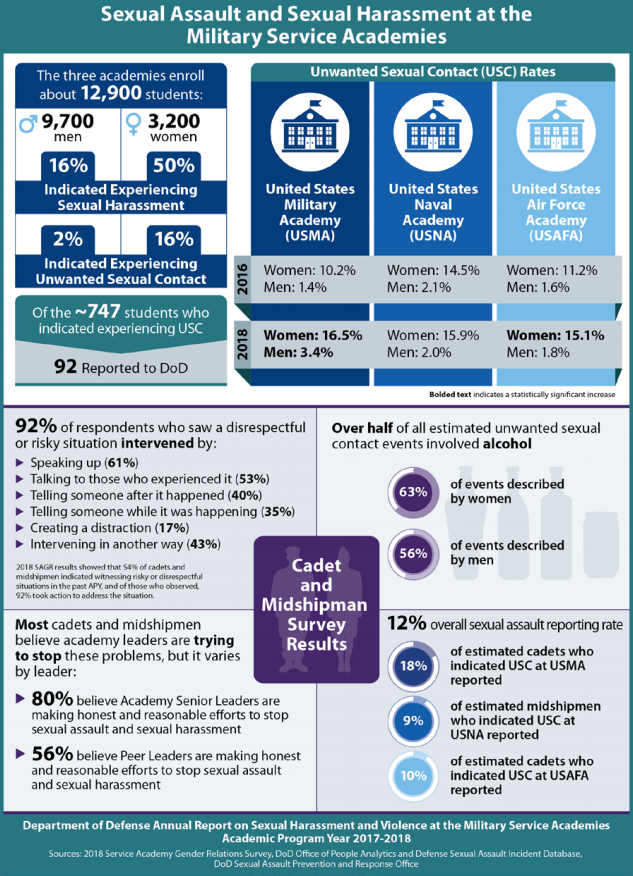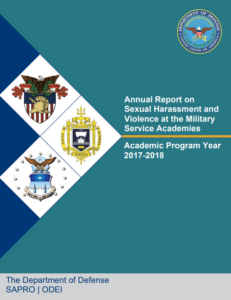Unwanted sexual contact in 2017-2018 increased for cadets and midshipmen compared to rates last measured in 2016, according to figures released by the US Department of Defense Sexual Assault Prevention and Response Office. Among all female cadets and midshipmen, 15.8% experienced unwanted sexual contact in the past year in the 2018 survey, an increase from 12.2% in 2016.
The figures came from the DoD’s scientific survey of the Academies, under its 13th Annual Report on Sexual Harassment and Violence at the Military Service Academies (MSAs) for Academic Program Year (APY) 2017-2018, released on 31 January.
The report on the three MSAs provides data on sexual harassment complaints and sexual assault reports involving cadets and/or midshipmen, as well as updates to policies, procedures, and processes implemented in response to sexual harassment and violence during the APY.
Key findings
- Among all female cadets and midshipmen, 15.8 % experienced unwanted sexual contact in the past year in the 2018 survey, an increase from 12.2 % in 2016.
- Similarly, 2.4 % of men experienced unwanted sexual contact in the past year, compared to 1.7 % in 2016.
- Unwanted sexual contact estimates only increased for women at the US Military Academy and US Air Force Academy, while estimates for men only increased at the US Military Academy.
- No statistical changes in estimates of unwanted sexual contact were observed among female and male midshipmen at the US Naval Academy or for male cadets at the US Air Force Academy.
- While the overall prevalence of sexual assault increased this year, reporting of the crime remained at about the same as last year.
- The Academies received a total of 117 reports of sexual assault involving cadets and midshipmen in Academic Program Year 2017-2018, five more reports than last year. Among these reports, 69 were Unrestricted and 48 remained Restricted at the close of the academic period.
- The US Military Academy observed an increase in reports of sexual assault, receiving 56 total reports (43 Unrestricted and 13 Restricted Reports), up from 50 reports last year.
- The US Naval Academy received 32 reports (17 Unrestricted and 15 Restricted), an increase of three reports from the previous year.
- The US Air Force Academy received 29 reports (9 Unrestricted and 20 Restricted), down from 33 reports last year.
- This year’s survey showed that an estimated 50 % of women and 16 % of men experienced sexual harassment in the past year.
- The rate of sexual harassment at the US Military Academy remained statistically unchanged for women (46 % in 2016 to 48 % in 2018) and increased for men (13 % in 2016 to 17 % in 2018).
- Estimated rates also increased at the US Naval Academy for both women (56 % in 2018 versus 51 % in 2016) and men (17 % in 2018 versus 12 % in 2016).
- At the US Air Force Academy, the estimated rate of sexual harassment remained statistically unchanged at 46 % for female cadets (47 % in 2016), and 13 % of male cadets (11 % in 2016).
- Fewer cadets and midshipmen chose to make sexual harassment complaints this year than last year.
- Across the Academies, there were seven informal complaints and zero formal complaints. The total seven complaints are down from the 16 received last year.
- Of the seven total complaints of sexual harassment made this year, the US Military Academy received four informal complaints, the US Naval Academy received two, and the US Air Force Academy received one.

Recommendations for the academies
- Continue to execute and implement respective plans.
- In execution of plans, ensure activities are integrated into a cohesive comprehensive strategy, have been or are being evaluated, and are implemented with fidelity in a supportive climate.
- Employ the technical assistance recently provided by the Department to address gaps in these areas.
This year’s assessment finds that sexual assault and sexual harassment are insidious, persistent challenges that do not remit easily — especially in unique academy environments,
…the official report reads.
See further details in the PDF below































































